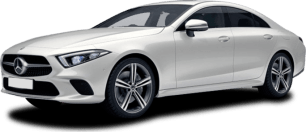Like the second-gen (H247) GLA, the EQA sits up high, offering lofty seating. That’s core to this range’s appeal, making getting in and out a less acrobatic feat compared to smaller and lower EVs.
The cabin is very similar to many of the second-generation MFA2 transverse-engine/front-drive-based Benzes like the current A-Class. That means solid looking and feeling doors and dash, upping the sense of quality. Very on-brand stuff.
This is a very modern and inviting interior, with those aforementioned screens set within a large rectangular binnacle. To the centre there are the trio of turbine-style air vents that still bring a spark of joy to the cabin (as well as seriously effective ventilation), along with the row of metallic toggle switches; both provide pleasing, high-quality sensory experiences.
It can lean towards overkill with a trashy night-club ambience if restraint is not exercised with the (configurable) coloured light show dotting the EQA's cabin.
Not to everybody’s liking, but thankfully you can turn that stuff off, so no complaining necessary here.
You wouldn’t call the EQA particularly spacious with its curvy roof, snug sports seating, high waistline, narrow glass areas and thick pillars, but even 200cm-tall people should find enough legroom up front. There’s a sense of cosiness rather than crampedness.
The 350 4Matic’s sports seats do a great job holding and caressing you in, providing excellent bracing through tight corners. Three’s ample (powered) adjustment, including for lumbar and lower-back areas, as well as enough support for thighs. The cushions themselves are typically firm yet comfy. And the seats look great.
The driving position is superb, ahead of a set of vibrant digital instrumentation choices that run the gamut of tastes, with the 'Classic' dial-like look and minimalist settings (reminiscent of Saab in its essentials-only display) included, so as to not scare away traditionalists. There is also a 'Progressive' screen that’s colourful and techy, though the info presented is a lot to take in.
What may not please conservative Benz buyers are the cheap-looking plastics dotted throughout the interior, along with the rattles that are regular companions, especially over less-than-smooth roads.
This has been a bugbear of all MFA-platform vehicles for more than a decade now, and while better than in some previous models, the EQA at $100K should possess vault-like build quality, not squeaky trim.
And when will that small and flimsy gear selector stalk be binned?
Our test car’s ‘Hey, Mercedes’ voice control system was erratic at best, barely providing any assistance and regularly annoying/entertaining with misunderstood responses and laughably limited functionality. Was our example glitchy? Perhaps.
Storage is good. And, ergonomically, everything’s within reach of the driver, but there’s a lot to take in, with scattered switchgear.
It’s also worth noting that, if you’re new to the MBUX multimedia system, taking the time to learn its many functions and capabilities is advisable, as it’s more logical and simpler than the intimidating first impression suggests.
A deft thumb is required for the steering-wheel spoke-actuated tabs for instrument data, but even technophobes ought to master it all eventually.
The central part of the screen can be swiped to access the vast array of features, including the excellent audio system and detailed vehicle control settings.
Further back, passengers sit up high, giving a wide view of what’s happening up front, while the backrest is angled at just the right position.
There’s not much fun to be had sitting on the raised middle bit, and shoulder space is seriously limited with three abreast, but otherwise, even adults should find sufficient legroom and headroom – even with the panoramic sunroof fitted.
Deep door pockets, face-level air outlets, reading lights and a folding armrest are to be found back there, though the latter includes a flimsy slide-out cupholder set that’s not worthy of the brand.
Because there’s a battery pack in the rear half of the EQA, cargo capacity shrinks from the donor GLA's 435 litres to just 340L, while dropping the 40/20/40 backrests extends that into the cabin for a 1320L load space. Note there’s no spare wheel, just a tyre inflation kit.
People don’t buy these small crossover Mercedes models for space or practicality – that’s why the GLB/EQB exist – but the EQA isn’t too bad for the urban demographic which wants/needs a compact, high-riding EV with impressive ground clearance.






